
Diseases of the upper respiratory tract are those kinds of ailments that affect both adults and children. Laryngospasm is a frequent occurrence of respiratory diseases. At the time of attack of this disease in humans, uncontrolled contraction of the muscles of the larynx occurs. As a result, dyspnea, loss of voice and other unpleasant symptoms appear. In the article we will consider why adults and children may develop laryngospasm, and what are the main signs of this disease.
Contents
- 1 Features
- 2 Reasons for the appearance of
- 2.1 In children
- 2.2 In adults
- 3 Symptoms
- 3.1 In children
- 3.2 In adults
- 4 First aid
Features
It is necessary to know that during an attack of laryngospasm, the vocal cavity may be slightly narrowed,so be completely blocked. In the latter case, a person can not even say anything. This leads to, so-called, inspiratory dyspnea - a rather difficult condition, which even an adult person suffers with difficulty. Most often, along with laryngospasm, there is also tracheospasm, which further aggravates the patient's condition.
The disease can occur in adults, but it affects children more often, especially infants - those who are not yet two years old. In most cases, children are exposed to him, who are fed with purchased mixtures.
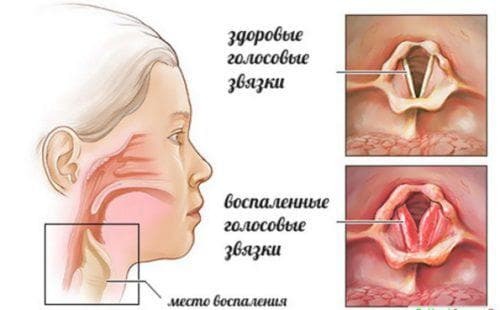
In the photo, it looks like laryngospasm
It should be noted that the disease is very dangerous, and in case of untimely care, it can even lead to death.
Reasons for the appearance of
In children
Calcium deficiency is one of the most common causes of indisposition. That is why it is so important to provide the child with this valuable mineral from an early age. It is not necessary and adults forget about replenishing the lack of calcium by taking appropriate vitamins and proper nutrition.
Reduced reactivity of the body and slowing of metabolic processes sometimes also lead to the appearance of laryngospasm.
Birth injury is often the cause of this ailment in children. Disturbed metabolism is also one of the reasons.
On video laryngospasm in children:
Some diseases - for example, chorea, bronchopneumonia, rickets often become the causes of pathological changes, and the emergence as a result of their laryngospasm.
If you have to instill medications with an adrenaline-containing composition due to some illness, it is likely that laryngospasm will be acquired.
Chronic dysfunction of the nervous system. This cause is congenital, so attacks of laryngospasm in this case occur in the child at the earliest age. If the baby has rickets, growth of the thymus gland or dropsy, most likely, he will also be prone to regular attacks of laryngospasm.
A child can swallow a small toy item or a button. The foreign body, caught in the windpipe, can cause an attack.
The most frequent attacks are children at the end of winter and early spring. This is the time when the body is most susceptible to vitamin deficiency and is vulnerable due to lack of nutrients.
In adults
In this case, the causes of the disease will be slightly different.
If a person is forced to treat the throat with caustic, aggressive and potent drugs, it is likely that as a result this will lead to laryngealism. If the larynx has a benign tumor, the likelihood of seizures increases dramatically.
On video laringospazma in adults:
If a person has a tendency to allergies, then as a result of inhalation and ingress of pollen, particles of wool and other allergens into the respiratory tract, there is a likelihood of laryngospasm appearing against this background.
Swelling of the larynx and its inflammation often lead to the appearance of laryngospasm.
Stressful situations and nervous overexertion, excessive excitement can lead to an attack. But in this case, the disease will not be associated with pathological changes in internal organs, and when rendering the proper help, it can no longer repeat itself.
The appearance of laryngospasm in adults can result in such diseases as bronchopneumonia, spasmophilia, chorea, as well as other pathologies of respiratory organs, especially the trachea, bronchi, larynx. Dysfunction of the gallbladder, too, in some cases, cause laryngospasm. If there are diseases of thyroid gland, especially - goiter, it often also causes attacks of laryngospasm.
Uncontrolled hysterical attacks lead to the appearance of laryngospasm. Especially often, people with the corresponding structure of the nervous system and unstable psyche are prone to such attacks.
The ingestion of foreign objects into the larynx is also sometimes the cause of a sudden attack of laryngospasm. Inhalation of caustic vapors or powder suspensions, for example, when using detergent powders or household products may well cause an attack.
With a strong runny nose, the separated phlegm can flow into the larynx - in this case the risk of an attack of laryngospasm is high. With sloppy or too fast food intake, small pieces of food can also get into the windpipe, provoking an attack.
If during the runny nose and colds lubricate the throat with menthol drugs or containing lapis, this can lead to complications in the form of an attack of laryngospasm.
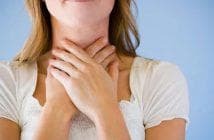 But the better it is to gargle with chronic tonsillitis, and what means the best, will help to understand this article.
But the better it is to gargle with chronic tonsillitis, and what means the best, will help to understand this article.
It will also be interesting to learn how to properly gargle with soda and salt.
It is also worth knowing whether Miramistin helps with sore throats, and how effective this tool is: http: //prolor.ru/g/lechenie/ miramistin-pri-angine.html
It will also be interesting to learn about why the feeling arises as if it strangles the throat.
Symptoms of
Consider what is the symptomatology of this disease, and how exactly laryngospasm manifests in adults and children.
The children
- The child is noisy and heavily breathing. Every new sigh is given to him with great visible difficulty, he suffers - and this is noticeable. The breath becomes noisy, wheezing. If the attack passes in a mild form, then after a heavy inhalation a deep and long exhalation takes place, after which the breathing normalizes and the child's condition returns to normal. But if laryngospasm is delayed and takes place in a complicated form, the consequences of it can be much more serious.
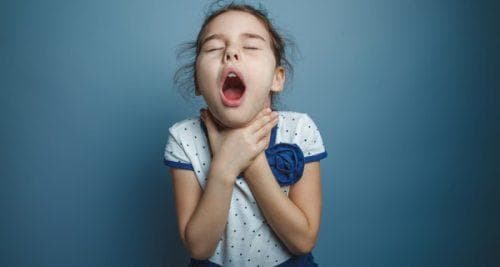
In the picture, the symptoms of laryngospasm in children
- The attack in a child usually lasts a few seconds. But in severe cases can be delayed and up to 2-3 minutes. His head involuntarily throws back, he arches his back, bends.
- The eyes of the baby can temporarily lose sensitivity to the bright light, generally not reacting to it at all, the stomach is strained.
- The area around the lips turns blue and turns pale.
- The neck muscles are usually very tight during an attack. Attentive parents will easily notice these signs.
- The child's mouth is open, he tries to take a deep breath.
- There is heavy sweating.
- Weak, threadlike pulse. Keep in mind that if this symptom is already there, then it's time to provide urgent, urgent help - the case may not end in the most rosy way.
Similar attacks can occur up to several times a day. Most often they can be observed in the daytime.
If the disease occurs in a more severe form or is aggravated by concomitant diseases, the following symptoms may appear:
- Syncope.
- Convulsions.
- In especially severe cases, foam comes from the mouth. The condition resembles an attack of epilepsy.
- Sometimes, children may have involuntary emptying of the bladder and intestines.
- In the most severe cases, which, fortunately, happen rarely, cardiac arrest occurs.
Often in children, a seizure occurs when the child coughs or becomes too hysterically crying. That is why it is important to help the baby in time to prevent such attacks from escalating into something more serious and dangerous. By the way, it is not recommended to laugh or be afraid of children too much. Such an excited state can affect the state of the psyche, and lead to an attack of laryngospasm. A situation may arise which is sometimes described as "caught breath".
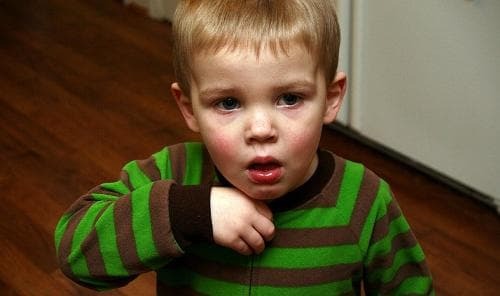
On the photo- the child is breathing heavily with laryngospasm
The disease most often manifests itself suddenly. Therefore, after the first attack, parents should already be at the ready - at any time the child can "stop by" in the next. After the attack has passed, the child usually falls asleep for a short time. During this period the body regains strength after the shocks experienced.
Children's laryngospasm passes much harder than an adult. In addition, if an adult can take the necessary measures himself, the child can not do this. And most likely, he will not be able to react to the requests of adults. Parents will have to take care of the baby completely in their own hands.
In adult
"Adult" symptomatology is somewhat different:
- Sometimes a person can observe a convulsive condition: involuntary contraction of the larynx and limbs.
- If laryngospasm occurs in mild form, then this may lead to narrowing of the glottis. This form does not lead to the appearance of severe symptoms.
- Blueing and blanching of the skin in adults is also observed. Often there are involuntary sobs.
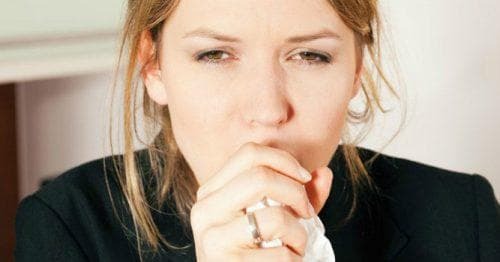
On the photos, the signs of laryngospasm in adults
But how to smear a child with Lugol's throat, and how effective this tool is.will help to understand this article.
It will also be interesting to know about what to treat the red throat for a child 1 year.
And here's how the red throat is treated without the temperature of an adult, and what are the best and effective remedies indicated in this article.
You may also be interested in learning about how to treat the red throat of a newborn and what means are the best, is described in great detail in this article.
But what to treat the pains of the nasopharynx at home, and what medicines are the best, is described in great detail in this article.
First aid
How can I help if a loved one, a child or you yourself has had an attack of laryngospasm. Some useful tips that will help to provide emergency help while you wait for the doctors.
Necessarily the patient needs to be reassured, if it is a child - to take on hands. The room should be fresh air - perhaps, the attack is caused by allergic causes, and the influx of fresh air will help to cope with the concentration of allergens in the room.
It is necessary to unfasten a tight collar or clasps on an adult or child's clothing - it is important that no external stimuli interfere with free breathing.
You need to give a person water. If it is a question of the child, then it is better for him to give water from a bottle. She should also moisten the face of the sick person.
On video treatment of laryngospasm at home:
It is necessary to somehow distract a person from paroxysmal manifestations. For example, doctors recommend slightly pinching, pulling the skin, gently pulling at the hair, pulling at the tongue. These simple actions often help to bring the patient into "feeling".
If an attack hits you, it is recommended that you follow the steps listed above, and try to induce vomiting or hold your breath - this often helps. If the attack is delayed, you can give the patient to take a solution of potassium bromide in a 0.5% ratio. Also in the treatment of an attack of laryngospasm, the inhalation of a soda solution or ammonia can help.
Let's sum up: as we have seen, an attack of laryngospasm is quite a serious phenomenon, and can threaten the health and lives of adults and even children. Therefore, the treatment of this disease must be taken very seriously, and take all necessary measures to prevent the attack from recurring. Our advice and advice from a competent specialist in a medical institution will help you protect your health from manifestations of laryngospasm.
